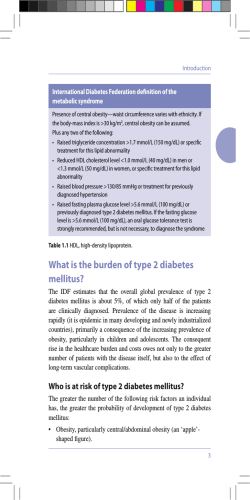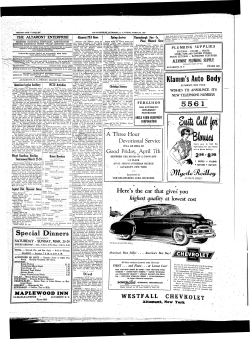
What is the difference between type 1 diabetes mellitus and... Type 1 diabetes is an autoimmune disease where the body...
Anamarie Orgera October 24, 2011 Medical Nutrition Therapy DFM484 Julie Matel Case Study 23 Nutrition Therapy for Diabetes Mellitus What is the difference between type 1 diabetes mellitus and type 2 diabetes mellitus? Type 1 diabetes is an autoimmune disease where the body attacks its pancreas and destroys the Beta cells, killing their ability to produce insulin. Type 1 requires insulin injections to move sugar out of the bloodstream and is usually diagnosed before the age of 40. Type 2 diabetes is when sugar is less efficiently moved out of the bloodstream than normal causing hyperglycemia. Type 2 is due to a lack of physical activity, poor eating habits and can be hereditary. Recently, it has been diagnosed at alarming rates in children even though it was previously considered “adult onset”. How would you clinically distinguish between type 1 and type 2 diabetes mellitus? Type 1 diabetes is when there is an absolute deficiency of insulin due to destruction of pancreatic beta cells. Which means the cells will no longer be able to use glucose and energy. This leads to two problems: hyperglycemia and cell starvation. To compensate for hyperglycemia, glucose is lost in the urine leading to glycosuria and polyuria. This will then lead to polydipsia so to combat fluid loss as well as polyphagia to attempt to fix the starving cells. As additional hormones are produced, lipolysis occurs and transforms those fats into keto acids which cause a drop in pH and ketone bodies are excreted. Deep breaths then take over to try to balance the ketoacidosis. As total body water decreases, so do crucial vitamins and minerals. Hypovolemic and muscle catabolism are also the cause of serious weight loss. This can lead to hypovolemic shock and eventually death. Make sure to check for presence of auto-antibodies. Type 2 diabetes is caused by insulin resistant tissues, which leads to an increased need for insulin and eventually an overworked pancreas resulting in its inability to function. Two metabolic problems then occur: insulin resistance and relative insulin deficiency. Clinical onset is due to the decreasing pancreatic release of insulin. The insulin resistance is caused by a cellreceptor defect which means the body is unable use insulin as well as unable to take up glucose from the blood. Because insulin is unable to inhibit glucogenolysis and gluconeogenesis, the liver responds by producing excess glucose. What are the risk factors for development of type 2 diabetes mellitus? What risk factors does Mrs. Douglas present with? Anamarie Orgera October 24, 2011 Medical Nutrition Therapy DFM484 Julie Matel Risk factors for development of type 2 diabetes include obesity, family history, and history of gestational DM, impaired glucose metabolism and physical inactivity. The risk factors that relate to Mrs. Douglas are obesity, as she is diagnosed with cellulitis, family history- her sister has type 2 DM for ten years now, age, ethnicity and physical inactivity. She is a homemaker that cares for her sister, so despite cooking meals she probably does not get very much exercise nor leave the house often. There will also be complications of neuropathy, nephropathy, heart disease and retinopathy. What are the common complications associated with diabetes mellitus? Describe the pathophysiology associated with these complications, specifically addressing the role of chronic hyperglycemia. Common complications with diabetes mellitus include hypoglycemia with symptoms of weakness, shakiness, perspiration, hunger and rapid heartbeat. If hypoglycemia is severe; the individual can lose consciousness or become so confused that he or she is unable to think clearly. They will become lethargic or belligerent. Weight gain from improved glycemic control. Severe hyperglycemia is also known as Diabetic Ketoacidosis (DKA) and is most common in type 1 diabetics. Symptoms of DKA include nausea, vomiting, stomach pain, fruity or acetone breath, Kussmaul respirations and mental status changes. Pathophysiology- when there is not enough insulin available, glucose production is stimulated by way of gluconeogenesis and lipolysis due to regulatory hormones in order to avoid cell starvation. A byproduct of lipolysis is the production of ketone bodies which can cause osmotic diuresis with accumulation in the blood. Dehydration and electrolyte imbalances then occur and result in hyperglycemia. Does Mrs. Douglas present with any complications of diabetes mellitus? Of yes, which ones? Mrs. Douglas does present complications of DM. These include dry mucous membranes in the nose, throat and skin and mild diminished sensations in the feet. Prior to admission, Mrs. Douglas had not been diagnosed with diabetes mellitus. How could she present with complications? It is possible that Mrs. Douglas had not been screened for Diabetes in years Calculate Mrs. Douglas’s body mass index (BMI). BMI = 30.3 Anamarie Orgera October 24, 2011 Medical Nutrition Therapy DFM484 Julie Matel What are the health implications for a BMI in this range? This BMI range indicates obesity (class 1). Calculate Mrs. Douglas’s energy needs using the Harris Benedict equation. Should Mrs. Douglas’s weight be adjusted for obesity? 655.1 + 9.6 (45.5) + 1.9 (152.4) – 4.7 (71) = 655.1 + 436.8 + 289.6 – 333.7= 1047.8 x 1.3 = 1362.1 kcals -Mrs. Douglas’s weight was adjusted to her IBW to take into consideration her obesity, and a stress factor of 1.3 was added to take into account her foot lesion. Calculate Mrs. Douglas’s protein needs. 155 / 2.2 = 70.45 x 1.3 = 92-95kg of protein Is the diet order of 1,200 kcal appropriate? Yes, I think the diet order of 1,200kcals is appropriate due to the fact that she is obese, however protein intake should not be decreased at all. Using a computer dietary analysis program or good composition table, calculate the kcalories, protein, fat, CHO, fiber, cholesterol, and Na content of Mrs. Douglas’s diet. food item 1 c black coffee 1 fried egg 2 pieces bacon 1/2 c orange juice enriched white bread 1 slice bologna 1 slice American cheese 1 packet mustard iced tea turnip 2 new potatoes 2 in cornbread 1 tsp. butter 3/4 c beans 1/4 c ham kcals 82 92 70 6 160 88 protein 0.6g 6.3g 4.5g 0.9g 6g 2.9g fat 1.5g 7g 5.5g 0.3g 2g 2.9g carbohydrate 16.5g 0.4g 0.5g 14g 28g 1.1g fiber 0.3g 0g 0g 0.3g 2g 0g cholesterol 5mg 210mg 15mg 0mg 0mg 16mg sodium 15mg 94mg 234mg 1mg 260mg 302mg 105 3 0 70 67 300 25 157 47 6.2g 0.2g 0g 2g 0.1g 5g 0.9g 519.1g 6.2g 8.8g 0.2g 0g 0g 3g 7.5g 2.9g 0.7g 2.2g 0.4g 0.4g 0g 8g 9.3g 28g 0.1g 28g 0.1g 0g 0.2g 0g 4g 1.3g 0g 0g 9.3g 0g 26mg 0mg 0mg 0mg 0mg 0mg 8mg 0mg 16mg 417mg 56mg 7mg 980mg 347mg 0mg 20mg 3mg 393mg 1 c black coffee 2 vanilla wafers TOTALS 80 0.6g 35 0.3g 1387 31.2g 1.5g 16.5g 1.3g 5.5g 2.6g 9.7g Anamarie Orgera October 24, 2011 Medical Nutrition Therapy DFM484 Julie Matel 0.3g 5mg 15mg 0.1g 0mg 30mg 1g 16.7mg 176.3 How would you compare Mrs. Douglas’s “usual” dietary intake to her current nutritional needs? Mrs. Douglas consumes too few of proteins in her usual diet as well as too high of kcals sine she is physically inactive. Identify the lab values that should be monitored regularly. Lab values of glucose, HbA1c, cholesterol, LDL, HDL, TGs should be monitored regularly. Select two high-priority nutrition problems and complete the PES statement for each. PES 1: inappropriate carbohydrate intake related to food knowledge deficit as evidenced by belief that carbohydrates are found only in foods with sugar. PES 2: excessive energy intake related to excessive carbohydrate intake as evidenced by BMI of 30.3. What was the most important nutritional concern when the patient was originally admitted to the hospital (time of Dx)? The most important nutritional concern when Mrs. Douglas was originally admitted to the hospital was possibility for type 2 diabetes due mainly to cellulitis and family history. For each of the PES statements that you have written, establish an ideal goal (based on the signs and symptoms) and an appropriate intervention (based on the etiology). Ideal goal for PES 1: gain knowledge of “good” vs. “bad” carbohydrate foods. Intervention for PES1: give Mrs. Douglas handouts on carbohydrate foods and schedule a couple more sessions where you can monitor diet and check that knowledge is being applied. Ideal goal for PES 2: consume less kcals and fewer carbohydrates overall. Intervention for PES2: smaller more frequent meals/ snacks that are balanced in protein, fat, carbohydrates.
© Copyright 2025


















